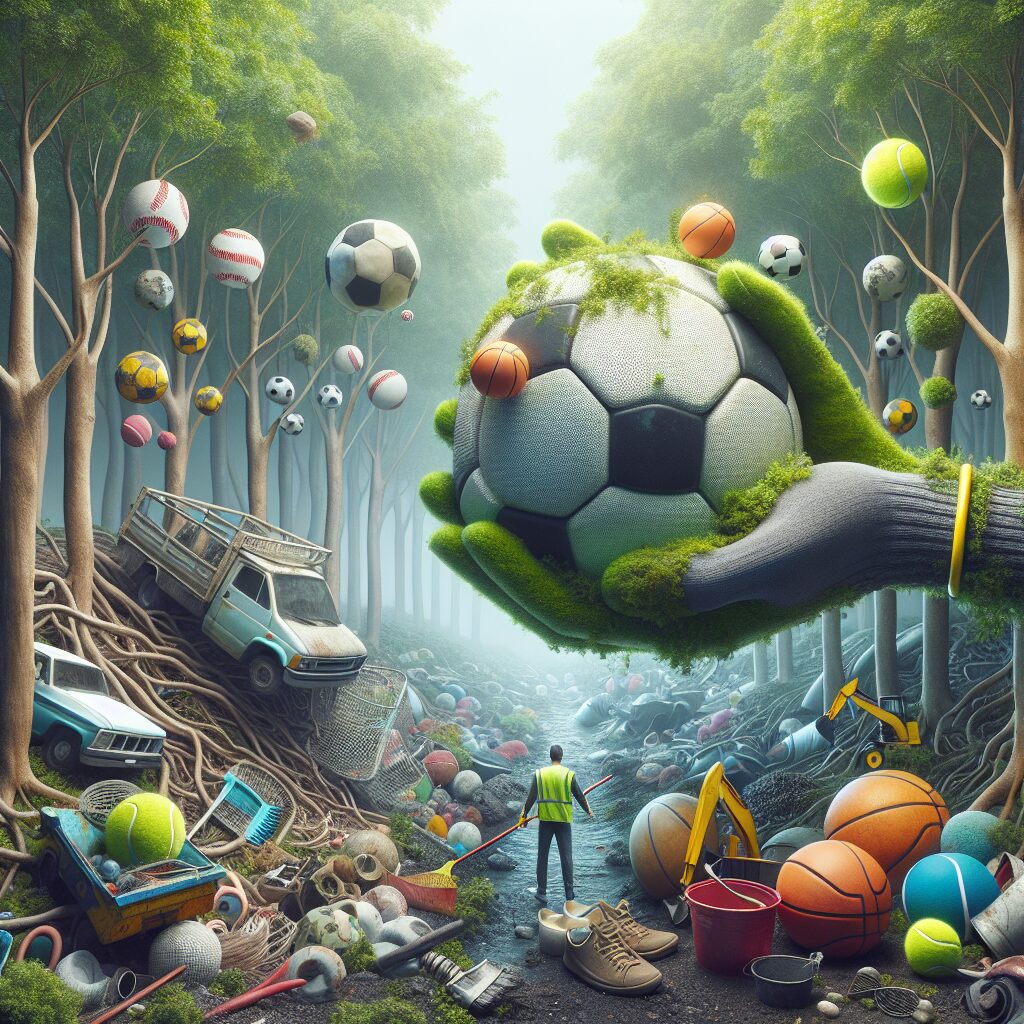Taking Responsibility: Addressing the Environmental Impact of Balls
Did you know that every year, billions of balls are manufactured, used, and discarded worldwide? From tennis balls to soccer balls, these seemingly harmless objects have a significant environmental impact. As we become more aware of our collective responsibility to protect the planet, it is crucial to address the environmental consequences of our everyday choices – even in the realm of sports and recreation.
A unique fact to consider is that many balls are made from materials that are not easily biodegradable. When a ball is worn out or damaged beyond repair, it often ends up in landfills, where it can take centuries to decompose. Beyond the waste disposal issue, the production of balls also contributes to environmental degradation. Factories that manufacture balls require energy, water, and raw materials, all of which have their own ecological footprint. When combined, these factors highlight the need for greater sustainability in the production, use, and disposal of balls. In the following sections, we will explore some key takeaways and possible solutions to address this issue effectively.
Key Takeaways
1. Environmental impact of sports balls: The production and disposal of sports balls, including soccer balls and tennis balls, contribute to various environmental issues like waste generation, carbon emissions, and chemical pollution due to their manufacturing processes and end-of-life disposal.
2. Addressing the manufacturing process: Manufacturers are increasingly adopting sustainable manufacturing practices by exploring alternative materials such as recycled rubber, eco-friendly adhesives, and non-toxic dyes. These efforts mitigate the environmental impact of sports balls by reducing carbon emissions and waste generation.
3. Recycling and repurposing: Proper disposal and recycling of sports balls can significantly reduce environmental impact. Many manufacturers and organizations have initiated take-back programs, encouraging consumers to recycle old balls or repurpose them for alternative uses, such as playground surfaces or pet toys.
4. Consumer behavior and awareness: Raising awareness among consumers about the environmental impact of sports balls is crucial. Encouraging responsible consumption by buying high-quality, durable balls and increasing their lifespan through maintenance and repair not only reduces waste but also saves money for consumers in the long run.
5. Collaboration and innovation: Collaboration among manufacturers, sports associations, and environmental organizations is essential to drive innovation and find more sustainable solutions. Research and development into biodegradable materials, eco-friendly production techniques, and circular economy initiatives can revolutionize the sports ball industry, making it more environmentally responsible.
How to Address the Environmental Impact of Balls and Take Responsibility?
Understanding the Environmental Impact of Balls
Balls, whether used in sports or recreational activities, have a significant environmental impact that must be addressed. The production, disposal, and usage of balls contribute to several environmental issues, including resource depletion, pollution, and waste generation.
Choosing Eco-Friendly Ball Materials
One crucial step in taking responsibility for the environmental impact of balls is selecting eco-friendly materials for their production. Opt for balls made from sustainable materials like natural rubber, organic cotton, or recycled materials. These alternatives reduce the extraction of finite resources and minimize pollution during manufacturing.
Reducing Plastic Waste
Plastic is one of the primary concerns when it comes to the environmental impact of balls. Many balls are made from synthetic materials, such as PVC or polyurethane, which are not biodegradable and contribute to plastic pollution. Explore and encourage the use of plastic-free and biodegradable alternatives to minimize the environmental footprint caused by ball waste.
Promoting Sustainable Manufacturing Processes
Another critical aspect of taking responsibility for ball environmental impact is promoting sustainable manufacturing processes. Encourage ball manufacturers to minimize energy consumption, reduce greenhouse gas emissions, and implement effective waste management systems. Sustainable manufacturing practices can significantly reduce the environmental footprint of ball production.
Encouraging Recycling and Proper Disposal
To address the environmental impact of balls, it is crucial to promote recycling and proper disposal practices. Encourage individuals, sports clubs, and organizations to recycle old balls or donate them for reuse whenever possible. Implement ball disposal programs that ensure responsible handling and prevent balls from ending up in landfills or polluting natural ecosystems.
Spreading Awareness and Education
Creating awareness is essential in addressing the environmental impact of balls. Educate individuals, sports enthusiasts, and manufacturers about the consequences of unsustainable ball production and consumption. By spreading knowledge, you can encourage responsible choices, sustainable practices, and the adoption of eco-friendly alternatives.
Supporting Sustainable Innovations
Promote and support sustainable innovations in ball production. Keep up with technological advancements that focus on reducing the environmental impact of balls, such as the development of renewable materials, energy-efficient manufacturing techniques, and circular economy approaches. By embracing sustainable innovations, the ball industry can play a significant role in minimizing its environmental footprint.
Guidelines for Taking Responsibility: Addressing the Environmental Impact of Balls
- How can individuals contribute to reducing the environmental impact of balls in their daily activities?
- What initiatives can sports clubs and organizations undertake to address the environmental impact of balls?
- Which steps can ball manufacturers take to implement sustainable practices that minimize their environmental footprint?
- How can recycling and proper disposal of balls be encouraged on a larger scale?
- What role does education and awareness play in reducing the environmental impact of balls?
- How can consumers support sustainable innovations in ball production?
Frequently Asked Questions
1. What is meant by “taking responsibility” in relation to the environmental impact of balls?
When we talk about taking responsibility, we refer to acknowledging and actively addressing the negative effects that different types of balls and their production processes have on the environment. This includes understanding their carbon footprint, waste generation, and other ecological considerations.
2. Do all types of balls have a significant environmental impact?
Not all balls have the same level of environmental impact. For example, sports balls made from synthetic materials like PVC or polyurethane contribute to carbon emissions during production and are not biodegradable. On the other hand, eco-friendly options such as those made from recycled materials or sustainably sourced natural materials have a lower impact.
3. What are some eco-friendly alternatives for sports balls?
There are several eco-friendly alternatives available for sports balls. These include balls made from recycled rubber, organic cotton, natural rubber, and even bamboo. Choosing such options helps reduce the carbon footprint, encourages sustainable practices, and contributes to a healthier planet.
4. How can I dispose of old or worn-out balls responsibly?
When disposing of old or worn-out balls, it’s important to follow proper recycling guidelines. Check with your local recycling facilities if they accept rubber, plastic, or other materials that the balls are made of. If recycling is not possible, consider donating them to organizations that can repurpose or reuse them.
5. Are there any initiatives or organizations working to address the environmental impact of balls?
Yes, there are various initiatives and organizations dedicated to addressing the environmental impact of balls. These organizations focus on research, development, and promotion of eco-friendly options while raising awareness about the negative consequences of conventional balls. Examples include sustainable sports associations and manufacturers committed to reducing their environmental footprint.
6. Are natural materials always better for the environment compared to synthetic ones?
Natural materials are generally considered more sustainable and better for the environment compared to synthetic ones. However, their environmental impact also depends on factors such as sourcing, production methods, and end-of-life disposal. It is essential to consider the entire lifecycle of a ball’s material when determining its environmental impact.
7. How can consumers make a difference in reducing the environmental impact of balls?
Consumers can make a difference by making informed choices. This includes opting for eco-friendly balls, supporting sustainable brands, and properly disposing of old balls to minimize waste. By actively considering the environmental impact, consumers can influence the market towards more sustainable practices.
8. What measures can manufacturers take to reduce the environmental impact of ball production?
Manufacturers can employ various measures to reduce the environmental impact of ball production. This includes using recycled or sustainably sourced materials, adopting energy-efficient manufacturing processes, minimizing waste generation, and investing in research and development to create innovative, eco-friendly technologies.
9. Are there any regulations governing the environmental impact of ball production?
Regulations regarding the environmental impact of ball production may vary between countries or regions. Some jurisdictions have specific guidelines or standards for sustainable production practices and waste management. However, it is important for manufacturers to voluntarily adopt environmentally responsible practices beyond what regulations require.
10. Can addressing the environmental impact of balls have broader positive implications?
Absolutely! Addressing the environmental impact of balls can have broader positive implications beyond the realm of sports. It raises awareness about sustainable practices, encourages innovation, and pushes for collective responsibility towards a greener future. By considering the environment in our choices, we can contribute to a more sustainable and resilient planet.
Final Thoughts
Taking responsibility for the environmental impact of balls is crucial in our journey towards sustainability. By understanding the various challenges and seeking eco-friendly alternatives, we can make a positive difference. Whether you are an avid sports enthusiast, a manufacturer, or a consumer, every little step counts in preserving our planet for future generations. Let’s come together to address this important issue and pave the way for a greener, healthier future.




